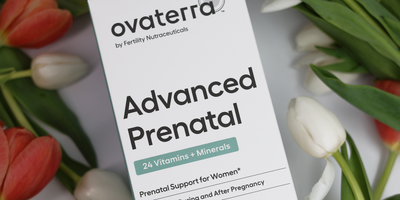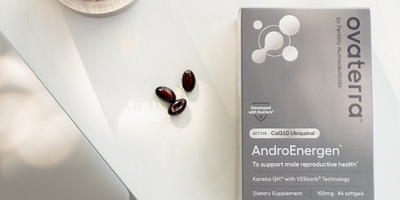What are Beta-Carotene and Vitamin A?
Both Beta-Carotene and Vitamin A are fat-soluble vitamins that play important roles in our health, including preconception and prenatal health. Beta-Carotene is converted into Vitamin A in the body, which supports vital functions of the body, including:
- Cell growth, including red blood cell production
- Development and maintenance of vital organs like the heart, lungs and eyes
- Vision
- Immune system
- Formation of male reproductive organs
- Sperm production
- Thyroid functions
- Fertilization of eggs and embryo implantation
- Placental development
Let's take a look at the difference between Beta-Carotene and Vitamin A, so you can safely take advantage of Vitamin A's pregnancy-supporting benefits.
What is the difference between Beta-Carotene and Vitamin A?
You can think of Beta-Carotene as a plant-derived, inactive form of Vitamin A. Beta-Carotene, once ingested, is converted into active forms of Vitamin A in the intestines. It’s an important source of Vitamin A, accounting for about 30% of all Vitamin A intake in developed countries. We also get several forms of already-active Vitamin A directly from diet, primarily through animal-derived foods.
Beta-Carotene
Beta-Carotene is one of the hundreds of carotenoids, which are pigments synthesized by plants. Carotenoids are converted into an active form of Vitamin A before they can participate in the many key functions of the body. Only a handful of carotenoids can become active Vitamin A, and beta-carotene is one of these few.
Vitamin A
There are three active forms of Vitamin A: Retinol, retinal and retinoic acid. Retinyl palmitate, an ester of retinol and palmitic acid, is the most abundant form of Vitamin A in animals, including us humans. Liver is the primary storage location of retinyl palmitate. Sometimes spelled (incorrectly) retinol palmitate, retinyl palmitate is considered a “preformed” Vitamin A, as it’s ready to do the work in the body without having to go through the conversion process.
What is RAE?
On the nutrition facts panel on food packaging or a supplement facts panel on prenatal vitamins, you may have noticed “RAE” following the amount of Beta-Carotene. It would look like this:

What does RAE mean? RAE stands for Retinol Activity Equivalents. Because different carotenoids have different levels of bioactivities compared to Vitamin A, the amounts of carotenoids in foods and supplements are expressed in terms of how much Vitamin A they are equivalent to.
How much Beta-Carotene is equivalent to Vitamin A?
How much Beta-Carotene do we need to do roughly the same amount of work in the body as Vitamin A? The answer depends on how you get the Beta-Carotene. If you are getting your Beta-Carotene from food, you need 12 times the amount of Beta-Carotene as preformed Vitamin A; if your Beta-Carotene is from supplements like prenatal vitamins, you need just 2 times the amount of Vitamin A.
The difference has to do with how we absorb Beta-Carotene and convert it into Vitamin A.
How is Beta-Carotene absorbed and converted into Vitamin A?
As a fat-soluble vitamin, Beta-Carotene needs to form a structure called a micelle in order to be bioavailable to our bodies for use. A micelle is a type of mollecule that contains a fat-soluble nutrient in the middle, with a water-soluble outer layer, which helps our water-based body to absorb and transport nutrients that otherwise would not dissolve in water.
Beta-Carotene from food can be difficult for the body to absorb. A study estimated, for example, only about 5-15% of Beta-Carotene in carrots forms micelles, making it potentially bioavailable. Of the Beta-Carotene that does form micelles, scientists estimate about 10-30% is actually absorbed in the intestines, although the range may be much winder – from 3% to 80%.
In contrast, studies have estimated that we can typically absorb 75-100% of preformed Vitamin A (retinol) . This difference in absorption rate appears to hold true for Beta-Carotene and Vitamin A in supplements like prenatal vitamins, although to a lesser extent (9-65% vs. 70-90%).
The final step before Beta-Carotene can be used to support baby’s organ development, immune system and more is the conversion into active forms of Vitamin A. When the Vitamin A levels dip, the body uses enzymes to convert Beta-Carotene into Vitamin A to top up.
It’s difficult to measure how much of Beta-Carotene is converted into Vitamin A in the body. However, scientists estimate that just 3.5 to 30% of Beta-Carotene we ingest may be converted into active Vitamin A.
Is Vitamin A better than Beta-Carotene?
At this point, you may be thinking: Vitamin A is more efficient, and thus better, than Beta-Carotene. After all, if you get your Vitamin A in the already active forms like retinyl palmitate, your body doesn’t need to activate it – and it appears easier for the body to absorb, too.
But there is an important flip side to the Beta-Carotene vs. Vitamin A comparison, especially during pregnancy: Vitamin A, if consumed in very high doses over 7.500 mcg/day, can increase the risk of birth defects in the baby’s cardiovascular and central nervous systems. Luckily, Beta-Carotene does not carry this risk.
This is why high-quality prenatal vitamins contain a mix of Beta-Carotene and preformed Vitamin A (like retinyl palmitate). By getting your Vitamin A from both Beta-Carotene and performed Vitamin A, you can make sure that your Vitamin A levels are healthy to reap its pregnancy-supporting benefits, while vastly reducing the risks of birth defects associated with very high preformed Vitamin A intake.
Note, too, that prenatal vitamins usually contain far lower than the 7,500 mcg level where doctors start seeing the risk of birth defects rising, or the 3,000 mcg/day that’s considered the safe upper limit. Some stand-alone Vitamin A supplements, however, can contain over 3,000 mcg/day, and should be avoided unless your doctor prescribes it for you.
What are the good sources of Beta-Carotene and Vitamin A?
Adult women need 700 mcg (RAE) of Vitamin A and/or Beta-Carotene each day. During pregnancy, the requirements go up to 770 mcg RAE to support the growing baby. You need even more – 1,300 mcg RAE – when breastfeeding. Adult men need 900 mcg/day, also RAE.
Here are a few good source of Beta-Carotene and Vitamin A (more foods are listed here):
- Beta-Carotene sources: Beta-Carotene is found in fruits and vegetables. Look for those in dark, rich colors, like sweet potato (700 mcg in half a sweet potato), spinach (just under 600 mcg in ½ cup, boiled), carrots (about 450 mcg in ½ cup, raw) and red peppers (about 100 mcg in ½ cup, raw).
- Vitamin A sources: Preformed Vitamin A comes in animal-derived foods, especially liver (a 3-oz portion of beef liver contains a whopping 6,500 mcg). Other sources include eggs (75 mcg) and fish, some fish, such as salmon (60 mcg in a 3-oz portion).
- Food fortification: Like Vitamin D and folic acid, Vitamin A is often added to breakfast cereals (90 mcg in 1 serving), dairy items like milk (150 mcg in 1 cup), yogurt (30 mcg in 1 cup) and cheese, as well as orange juice.
- Prenatal vitamins: For women who know they want to get pregnant soon, who are pregnant or breastfeeding, prenatal vitamins is a key tool to make sure all the nutritional bases are covered.
Outright deficiencies of Beta-Carotene and Vitamin A are rare among healthy women living in developed countries. However, many women do find it hard to meet the daily requirements from food alone when breastfeeding, as the recommended daily value almost doubles. This is another reason why doctors recommend sticking to your prenatal vitamins until you are done nursing.
What affects Beta-Carotene absorption and conversion to Vitamin A?
Several factors can influence how much of the Beta-Carotene in your diet is absorbed, and how much of that is converted into Vitamin A.
- Cooking: Unlike Vitamin C and other vitamins that break down when heated, Beta-Carotene actually becomes easier to absorb when cooked. So, top your spinach salad with roasted sweet potato for good measure.
- Presence of fat: Because Beta-Carotene is a fat-soluble vitamin (as is preformed Vitamin A), eating foods rich in Beta-Carotene with some fat helps with its absorption. So, sautéed peppers is better than snacking on raw ones in this regard.
- Food Itself: Scientists have found that Beta-Carotene in certain foods are easier for the body to absorb than in other foods. For example, a study found that Beta-Carotene in carrots may be 40% easier to absorb and convert to active Vitamin A than Beta-Carotene in spinach, possibly due to factors like what form it’s in, what it’s bound to, how easily digestible the vegetables’ cells are and so on.
- Genetics: There is some evidence that people with variations of the BCO1 gene may have a harder time with the carotenoid-to-Vitamin A conversion process. This gene encodes the enzyme that drives the conversion, and some people with variations of the BCO1 gene don’t make as much of the enzyme as people with the normal BCO1 genotype.
Bottom line on Beta-Carotene vs. Vitamin A
Vitamin A has a number of key roles to play in our systemic health, and supports a healthy pregnancy for both mom and the baby. While Beta-Carotene can be difficult for the body to absorb and convert into the active Vitamin A to fulfill these functions, it's a good source of Vitamin A that doesn't carry the risks of birth defects from excessive intake. So, aim for a good balance between Beta-Carotene and Vitamin A during your preconception, prenatal and postnatal periods to fully support you and your baby.
Please reach out if we can answer any questions about Vitamin A's role on your fertility journey. We are with you.
















